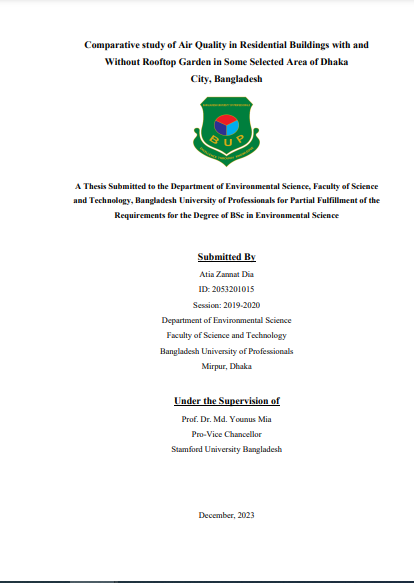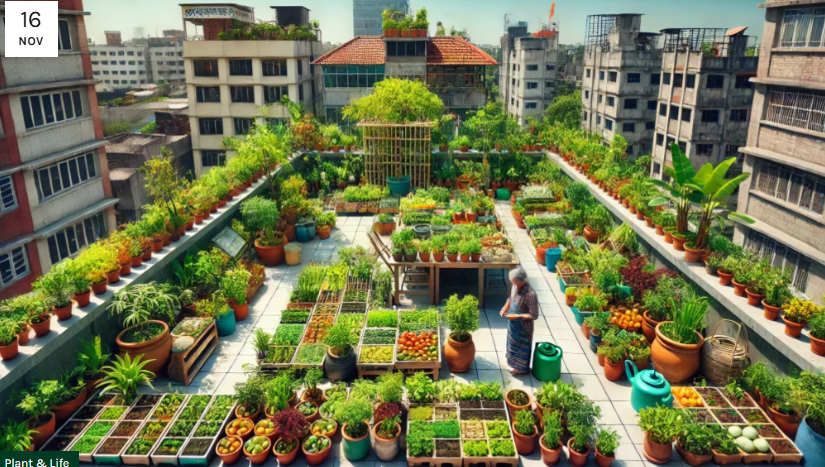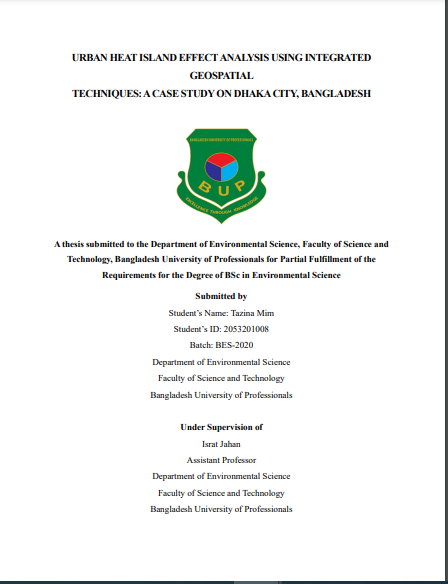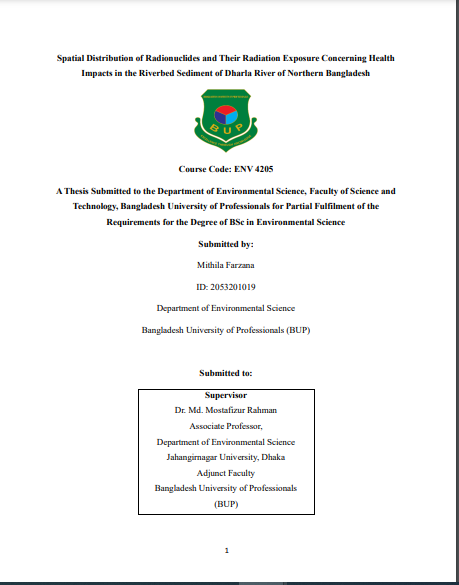
Thesis report: Rooftop Garden in some selected area of Bangladesh. In Comparative study of Air Quality in Residential Buildings with and Without Rooftop Garden in Some Selected Area of Dhaka City, Bangladesh.
Dhaka, the capital of Bangladesh, is among the world`s largest and fastest-growing cities in the world, spanning 306.4 square kilometers and housing approximately 23.21 million people (Dhaka, Bangladesh Metro Area Population 1950-2024).
Unfortunately, Dhaka unplanned growth has led to significant environmental challenges.
- The city has only 21.57% of open space,
- Parks accounting for 0.89%,
- Forestry making up 0.02%,
- Gardens making up 0.90%, and
- Agriculture making up 12.12% (M et al., 2015).
Over time, green space has been decreasing, while the number of buildings continues to increase without adequate consideration for environmental protection.
| Report Title : | Rooftop Garden in some selected area of Bangladesh. |
| University Name : | Stamford University Bangladesh |
| Submitted To : | Prof. Dr. Md. Younus Mia |
| Submitted By : | Atia Zannat Dia |
| Total Page : | 93 |
According to the Chief Town Planner for Dhaka City (2003), an ideal city should have 20% of its area covered by trees, but the city only has 8% of vegetation.
In the recent years the city`s air quality has been deteriorating despite some measures taken to address the issue. As urbanization continues to transform city landscapes.
The impact of building structures on environmental factors, particularly air quality, becomes a critical area of investigation. Green roofs have gained increasing popularity over the past two decades as a strategy to enhance urban sustainability by restoring ecosystem services.

The urgency of this research is driven by the critical need to address air pollution in Dhaka City and identify sustainable, innovative solutions for a healthier future.
According to the Bangladesh Pollution Action Plan (BAPA, 2002), air pollution contributes to headaches, eye irritation, throat pain, bronchitis, breathing difficulties, heart disease, anemia, mental disorders, kidney disease, and even cancer.
Objectives:
The key objectives of green roofs include mitigating the urban heat island effect prolonging–
- The lifespan of roof members,
- Intercepting storm water runoff,
- Filtering particulate matter from the air,
- Improving energy efficiency and
- Providing urban residents with locally grown food.
This research aims to explore and compare air quality in residential areas of Dhaka City, focusing on the presence or absence of rooftop gardens. By uncovering insights into the potential benefits of rooftop gardening.
The study seeks to evaluate its effectiveness in reducing air pollutants and creating healthier living spaces in densely populated urban environments. Using the UFORE model, Currie and Bass calculated that, green roofs in Toronto removed 7870 kg of pollutants annually.
Further Studies are needed to evaluate air quality on building rooftops and explore the potential of green roofs in improving air quality in residential areas and buildings.
Outline of the Thesis:
There are some outlines of the thesis are given below—
- In Chapter 01: Introduction, Including the problem statement, Rationale, Research gap, Objectives and Scope.
- In Chapter 02: Literature Review on urban air quality, rooftop gardens, residential air quality studies, and comparative research.
- In Chapter 03: Methodology, covering area selection, building criteria, data collection methods, and analytical techniques.
- In Chapter 04: Analysis and Results, with data presentation, comparative analysis, and discussion of findings in relation to prior studies.
- In Chapter 05: Conclusions and Recommendations for future research on residential air quality.
Problem Statement:
The air quality in residential buildings in Dhaka City has become a critical concern due to high levels of pollution caused by rapid urbanization and industrial activities (According to M. S. Islam, 2016).
This research addresses the lack of comprehensive understanding and empirical evidence regarding the impact of rooftop gardening on air quality in residential buildings in Dhaka City of Bangladesh.
Although green interventions like rooftop gardens are gaining interest as a means to mitigate air pollution, there is limited research specifically comparing air quality in buildings with and without rooftop gardens within this urban context.
This knowledge gap hinders effective decision-making in urban planning, sustainable development, and public health initiatives aimed at improving air quality in Dhaka City. As air pollution continues to intensify with the city’s growth, residents face increasing exposure to harmful pollutants.
This study highlights the urgent need to explore sustainable solutions, such as rooftop gardening, to enhance air quality and improve living conditions in densely populated areas.
Research Objectives:
- To assess and compare air quality and pollutant concentrations, including particulate matter (PM), nitrogen dioxide (NO₂), carbon dioxide (CO₂), ozone (O₃), total suspended solids (TSP), sulfur dioxide (SO₂), carbon monoxide (CO), and methane (CH₄), in residential buildings with and without rooftop gardens in selected areas of Dhaka City.
- Additionally, to investigate the impact of rooftop gardening on the air quality of these residential buildings.
Conclusion:
The research highlights the critical issue of air pollution in residential buildings within Dhaka City, driven by rapid urbanization and industrialization.
Rooftop gardening emerges as a promising intervention to enhance urban air quality, yet there is a notable gap in empirical studies comparing air quality in buildings with and without rooftop gardens.
This study seeks to fill this knowledge gap by assessing pollutant levels and evaluating the effectiveness of rooftop gardens in mitigating air pollution.
By employing a rigorous methodology, including comparative analysis and statistical evaluation, the research aims to provide actionable insights for sustainable urban planning and public health improvements.







